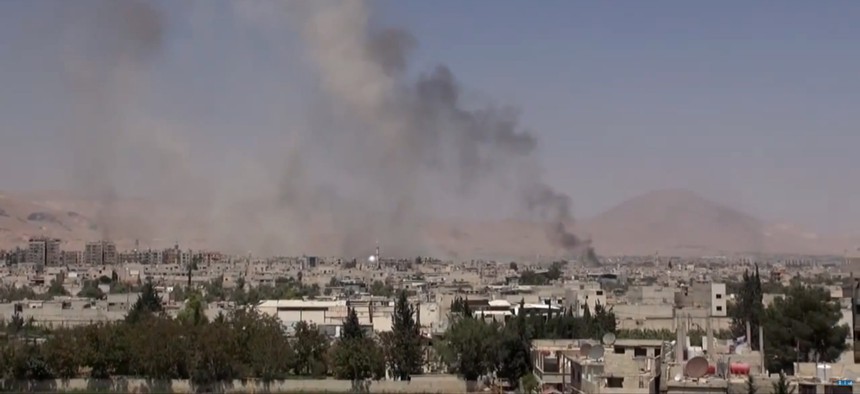
This image made from video posted online by the Shaam News Network, a loosely organized group opposed to Bashar Assad, on Sunday, Aug. 16, 2015, which has been verified and is consistent with other AP reporting, shows smoke rising over a Damascus suburb. Shaam News Network via AP video
US Train-and-Equip Program, by the Numbers: 9 Fighting, 18 MIA, 1 Killed
Pentagon updates the tally just days after CENTCOM shocked senators by reporting that only ‘4 or 5’ Syrians remained in the fight.
This is the U.S. proxy force in Syria, by the numbers: Of the first class of 54 to graduate the U.S. train-and-equip program, exactly nine are currently fighting in Syria, while 11 more members of the New Syrian Force — the Pentagon’s name for the group it hoped would become an effective anti-ISIS unit — are waiting outside the border to join the fight.
Fourteen have left the NSF to join some other moderate opposition group, while 18 more are somewhere in Syria, but missing. One has been reported killed, and one has been confirmed as kidnapped by Al Nusra Front, an al Qaeda affiliate.
On the bright side, all of their sophisticated equipment is accounted for and being held by another moderate opposition group, according to Col. Pat Ryder, spokesman for U.S. Central Command.
“Since Gen. Austin spoke, we went back and looked at this, and right now an additional four NSF fighters are in Syria, so there’s actually 9 — in addition to the five that he mentioned — there’s actually a total of nine now currently active in Syria,” Ryder told reporters at the Pentagon Friday. “We also have 11 NSF fighters who are not yet in Syria, and I’m not gonna talk to where they’re located outside of Syria, but that’s an additional 11, so — 20 NSF fighters part of the program.
“We have 14 who are in Syria with their parent opposition unit, but they’ve left the NSF program. We have 18 that are in Syria, but their whereabouts are unknown,” he continued. “We have one that was reported as killed in action during the defense of the NSF compound, but there’s no evidence to substantiate whether he’s dead or alive, and we have one who is in [Al-Nusra Front] captivity.”
On Wednesday, Gen. Lloyd Austin, the commander of CENTCOM, shocked senators when he reported that of the original class who graduated the U.S. program and were reinserted back into Syria, only “four or five” remained in the fight.
“It’s a small number,” Austin allowed.
Both he and Defense Undersecretary for Policy Christine Wormuth acknowledged there had been setbacks in the U.S. strategy for the fight against ISIS in Syria.
Ryder said Friday that since Austin spoke, four more fighters returned to Syria. “They went in after he made his statement, so the situation changed,” he said.
Though Ryder said the 18 are unaccounted for, he said to the Defense Department’s knowledge they have not joined groups on the other side of the fight, such as Al Nusra or ISIS.
“What I would tell you is that to our knowledge that is not the case, but again their whereabouts are unknown,” he said. “We do not command and control these forces.”
Ryder also explained that one reason for the disappointing pace of the program — initially intended to train 3,000 fighters by the end of this year and some 15,000 over three years — is an emphasis on security and quality, due to the sophistication of training and equipment provided to the fighters. But he assured that that equipment provided to the first group was accounted for.
“That equipment is currently in control of a moderate opposition group and we continue to coordinate with them,” Ryder said.
As for why the numbers had changed since Austin’s testimony on Wednesday, Ryder said, “I think you’ve seen, and are very aware of the fact, that this initial group was scattered to a certain degree. So that gives you a little insight into why the numbers would be like that.”
The first group of 54 was scattered with many of its members kidnapped and some killed almost immediately after re-entering Syria. Until Austin’s testimony, the Pentagon had refused for weeks to say how many fighters remained, and even after, declined to give information about the “individual disposition” of the other 49 or 50 fighters, citing operational security and their safety. Ryder said they are now doing so now to combat “misinformation,” but that such a delineation shouldn’t be expected in the future.
“I’m providing this information to clarify and set the record straight, but as for the disposition of those forces for future classes, future members of this program, please don’t expect we will provide this level of detail,” Ryder said. “We will continue to try and be as transparent as possible, but we don’t want to ever do or say anything to jeopardize them … and their ability to do their mission.”
According to reports Friday morning, the White House is considering abandoning the program altogether, while Pentagon spokesman Peter Cook said Thursday the department is asking the “tough questions” about how the program can be improved or amended. Member of Congress vowed to keep up their scrutiny of the $500 million program on Wednesday.
“Let’s not kid ourselves,” Sen. Kelly Ayotte, R-N.H. said of the small number remaining in the fight. “That’s a joke.”




